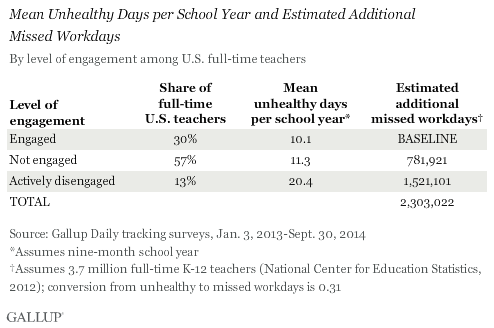Story Highlights
- Just 30% of U.S. teachers are engaged in their work
- Actively disengaged teachers average twice as many absences
This article is the first in a series exploring employee engagement among U.S. teachers as measured by Gallup Daily tracking.
WASHINGTON, D.C. -- In the U.S., K-12 schoolteachers who are "not engaged" or are "actively disengaged" at work miss an estimated 2.3 million more workdays than teachers who are "engaged" in their jobs.

Gallup categorizes survey respondents as "engaged," "not engaged" or "actively disengaged" based on their responses to questions about workplace elements with proven links to performance outcomes. Gallup defines engaged teachers as involved with, enthusiastic about and committed to their work. They know the scope of their jobs and constantly look for new and better ways to achieve outcomes. Not engaged teachers may be satisfied with their jobs, but they are not emotionally connected to their workplaces and are unlikely to devote much discretionary effort to their work. Actively disengaged teachers are not only unhappy, but also act out their unhappiness in ways that undermine what their coworkers accomplish.
Overall, 30% of U.S. teachers are engaged in their work, matching the national average for all workers.
A majority, 57%, of full-time K-12 teachers in the U.S. are "not engaged." They report, on average, 11.3 unhealthy days per school year -- days that keep them from doing usual activities -- resulting in an estimate of about 3.5 missed workdays per school year. Using engaged teachers as a baseline, all "not engaged" U.S. teachers miss an estimated 781,921 additional days of work each year.
Additionally, about 13% of U.S. teachers are "actively disengaged" in their jobs, somewhat lower than the 18% average for all American workers. These actively disengaged teachers average 20.4 unhealthy days per school year, resulting in slightly more than six missed workdays per school year -- more than twice as many missed workdays as engaged teachers reported. Using engaged teachers' absenteeism as the baseline, actively disengaged teachers as a group miss an estimated total of 1,521,101 additional days of work.
Implications
Gallup research has uncovered both individual and business outcomes consistently associated with employee engagement, including: well-being, absenteeism, turnover, workers' compensation claims, productivity, customer engagement, workplace safety and profit. Moreover, these findings have been demonstrated across companies and across industries. Here, Gallup adds evidence from the education space to the corpus of engagement findings, indicating that not-engaged and actively disengaged teachers miss more work than their engaged colleagues because of poor health. Altogether, the magnitude is substantial, estimated at a total of more than 2.3 million additional missed days each school year in the U.S.
Absenteeism associated with a lack of teacher engagement creates a drain on school productivity. Schools districts must foot the bill for classroom replacements. And when substitute teachers are relied on to execute a regular teacher's lesson plans, often with limited advance notice, it can easily create a suboptimal learning environment for students.
This analysis cannot establish the presence or direction of causality between level of engagement and missed workdays. However, teachers who work in school districts that foster teacher engagement likely are better positioned to face the workplace challenges associated with poor health, including the inability to do usual activities.
Estimation Methods
Unhealthy days per month are estimated by response to the question: "During the past 30 days, for about how many days did poor health keep you from doing your usual activities?"
To determine how unhealthy days per month were translated into an estimate of actual missed workdays, Gallup relies on the conversion factor established in previous research where Gallup asked respondents the following: "Earlier, you indicated that you had xx days in the last month where poor health prevented you from doing your usual activities. How many actual workdays in the last month did you not work due to poor health?"
Gallup estimated additional missed workdays for not-engaged or actively disengaged teachers as follows:
Step 1. Converted full-time teachers' average number of unhealthy days per month into an average for the school year, i.e., nine months.
Step 2. Converted the average number of unhealthy days into the average number of missed workdays each school year by multiplying each value by 0.31. The 0.31 conversion factor is based on an analysis of all U.S. employees that was released by Gallup in 2011.
Step 3. Calculated the difference in the average missed workdays between "not engaged" teachers and "engaged" teachers, as well as between "actively disengaged" teachers and "engaged" teachers.
Step 4. Estimated the number of full-time teachers in each engagement group based on 3.7 million U.S. teachers (National Center for Education Statistics, 2012). These estimates were then multiplied by the differences in missed days produced in Step 3 to estimate the additional missed workdays for "not engaged" and "actively disengaged" teachers.
Survey Methods
Results are based on telephone interviews conducted Jan. 3, 2013-Sept. 30, 2014, as part of the Gallup Daily tracking survey, for a subgroup of 6,711 self-identified full-time K-12 schoolteachers, from a random sample of adults, aged 18 and older, living in all 50 U.S. states and the District of Columbia. All reported margins of sampling error include computed design effects for weighting.
For results based on the total sample of U.S. teachers, the margin of sampling error is ±1 percentage point at the 95% confidence level.
Each sample of national adults includes a minimum quota of 50% cellphone respondents and 50% landline respondents, with additional minimum quotas by time zone within region. Landline and cellular telephone numbers are selected using random-digit-dial methods.
Learn more about how the Gallup U.S. Daily works.


